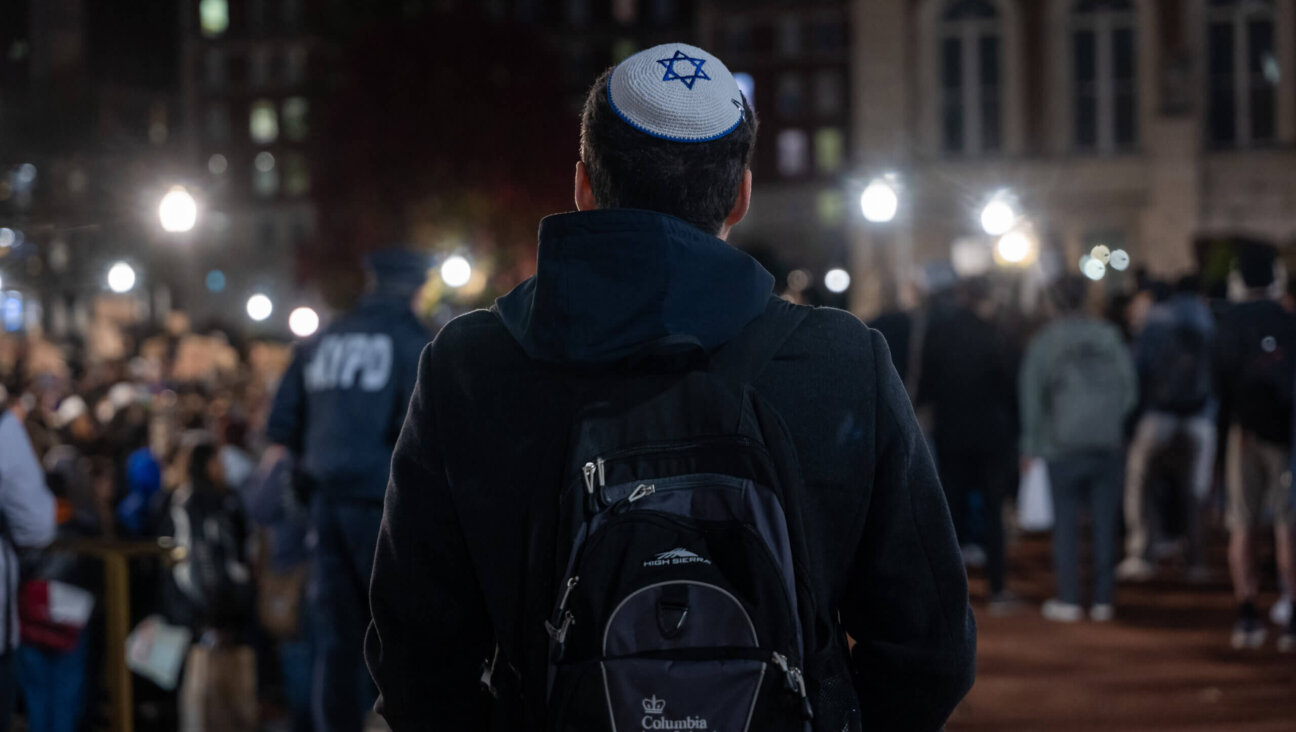Religious Zionists Enshrine Gaza Pullout In Mourning Ritual
Haifa, Israel — In Avi Ben-Shimon’s home in the West Bank town of Emmanuel, a memorial candle will burn throughout the fast day of Tisha B’Av, which begins at sundown August 9. It will not, however, commemorate the main theme of the 25-hour fast, which is the destruction of the two ancient Jerusalem temples. Rather, it will commemorate what Ben-Shimon calls a modern-day “tragedy” — evacuation of the Jewish settlements in Gaza.
As right-wing Knesset members turned to parliamentary procedure July 30 to vent their continuing anger over the 2005 disengagement, pushing through a bill for the creation of a commission of inquiry into alleged government neglect of evacuees, thousands of Orthodox Zionists like Ben-Shimon prepared to turn to another outlet: ritual.
The official deadline for voluntary departure of Gush Katif residents from their Gaza homes in August 2005 coincided with the Fast of Av, although a two-day extension was granted at the last minute. Opponents at the time drew parallels between the forced evacuation of Jewish communities and the long-ago destruction of the biblical temples. And now, despite objections from liberal sectors of the Religious Zionist community, this rhetorical connection is now being enshrined in ritual.
Those who light candles will be following a new directive from several leading rabbis of the Religious Zionist movement who are encouraging this and other mourning rites as part of an ongoing campaign to make the departure from Gush Katif an inseparable part of the mourning ceremonies of the Fast of Av.
“The candles are being lit to remember and light a new light for settlements,” said Shai Gefen, director of the right-wing activist group SOS-Israel, which expects to sell 300,000 specially produced candles across Israel before the fast. They come in a tin emblazoned with a slogan calling the Fast of Av the day of Gush Katif’s “churban” — an evocative word for “destruction” normally reserved for that of the temples and for the Holocaust.
The Fast of Av was instituted after the destruction of the Second Temple by Roman forces in August of the year 70, and later extended to commemorate the fall of the First Temple to Babylonian forces, traditionally thought to fall on the same date in 586 BCE. It has since absorbed other themes, which have been integrated into its liturgy, including crusades, various expulsions, pogroms and, most recently, the Holocaust.
The fact that the actions of the Jewish state are being mourned on a day previously reserved for lamenting calamities perpetrated on Jews on by non-Jewish regimes has evoked the fury of left-leaning Orthodox Zionists. Proponents of the parallel “are out of touch with reality” and their territorial ambitions unrealistic, said Aviezer Ravitsky, who is a founder of the left-wing Orthodox party Meimad and a professor of Jewish thought at Hebrew University. “I don’t see any reason to mourn because we can’t have Gush Katif,” he added.
Rabbi Yuval Cherlow, a leading proponent of moderate Religious Zionism and founder of the Tzohar organization for Orthodox-secular reconciliation, complained of a “lack of a sense of proportion.” He said that while he opposed the Gaza withdrawal, “if we compare the disengagement to events like the Holocaust, we will isolate ourselves. This will increase the isolation of the Religious Zionist movement.”
But from Gefen’s viewpoint, “It is actually more serious because Jews did it — not Nebuchadnezzar but Sharon.” He added: “In many ways, it was like the destruction of the temple. Twenty-three synagogues were lost.”
This belief prompted the call for candle lighting. It was signed by some of the leading rabbis of the Religious Zionist right, including Safed chief rabbi Shmuel Eliyahu; Yaakov Yosef, the popular Jerusalem rabbi and son of Shas spiritual leader Ovadia Yosef, and Dov Lior, chief rabbi of Hebron and Kiryat Arba and chairman of settler movement’s rabbinic arm, the Rabbinical Council of Judea and Samaria.
These rabbis are seen by some as firebrands, as is the man who heads the organization selling the special candles, Shalom Dov Wolpe of SOS-Israel. An educator associated with the messianic wing of the Chabad-Lubavitch Hasidic movement, Wolpe made headlines in January after alleging that if Israel were properly run, Prime Minister Ehud Olmert would be “hanged from the gallows.” In an interview with the Forward on July 28, he called the disengagement a “sin done by the government of Israel.”
Despite misgivings, there is “quite a broad-based backing for this kind of idea in the religious community,” said Hebrew University political scientist Mordechai Nisan, who has studied the disengagement.
Indeed, the bastion of the Religious Zionist establishment, the National Religious Party, views the candle campaign as a “good idea, as it’s important to remember this and to ensure that Israel does not neglect it and that it could not happen again,” party spokesman Yigal Amitai told the Forward. Summer camps and chapters of the Religious Zionist youth movement Bnei Akiva “will run ceremonies for Gush Katif” in which “they will make the connection between Tisha B’av and the evacuation,” movement spokesman Aviad Shahar said.
Amitai, asked if he is concerned that absorbing the disengagement theme into the Fast of Av would detract from the day’s solemnity, replied: “Someone wrote [for the day’s liturgy] on the Kishinev pogrom. Nobody would say this takes away from the day.”
In fact, liturgy is one of the other channels through which the disengagement theme is being injected into rituals of the Fast of Av. The day’s mourning is most intense when synagogue congregants sit on the floor and recite the biblical book of Lamentations, written after the First Temple was destroyed. Over the past 1,000 years, the structure of this book has been mimicked in poetic dirges called kinnot, which are also recited. Now, kinnot to the evacuation of Gush Katif are circulating and will be recited in many synagogues and homes.
One of these kinnot, distributed by the Shiloh Institute, which is an Orthodox research body that is developing a specifically Israeli liturgy, closely follows the style of Lamentations and early kinnot. It is titled “Eicha” — the first word of Lamentations — which means “how,” and subtitled “Dirge for the destruction of 25 settlements in the Land of Israel and the exile of their residents at the hands of their brothers from the House of Israel.”
The institute’s head, Rabbi Dawidh Bar-Hayim, told the Forward that the disengagement should be integrated into the liturgy of the Fast of Av because in addition to “the terrible danger in which the event placed all of Israel,” it shares a theme of “human tragedy” with other events commemorated. He was referring to reports that many evacuees have not been effectively resettled, such as a recent survey that found 81% are still in temporary housing and 50% are unemployed.
Pinchas Leiser, a spokesman for the dovish Orthodox group Netivot Shalom, said that his organization shares a belief that the Fast of Av should be used to reflect on recent events — though not the disengagement: “We consider intolerance and violence — the roots behind the destruction of the Second Temple — as the main problem of Israeli society that may lead to its destruction, and therefore, symbolically, we gather at Rabin’s grave on the eve of the Fast of Av.”

I hope you appreciated this article. Before you go, I’d like to ask you to please support the Forward’s award-winning journalism this Passover.
In this age of misinformation, our work is needed like never before. We report on the news that matters most to American Jews, driven by truth, not ideology.
At a time when newsrooms are closing or cutting back, the Forward has removed its paywall. That means for the first time in our 126-year history, Forward journalism is free to everyone, everywhere. With an ongoing war, rising antisemitism, and a flood of disinformation that may affect the upcoming election, we believe that free and open access to Jewish journalism is imperative.
Readers like you make it all possible. Right now, we’re in the middle of our Passover Pledge Drive and we need 500 people to step up and make a gift to sustain our trustworthy, independent journalism.
Make a gift of any size and become a Forward member today. You’ll support our mission to tell the American Jewish story fully and fairly.
— Rachel Fishman Feddersen, Publisher and CEO
Join our mission to tell the Jewish story fully and fairly.
Our Goal: 500 gifts during our Passover Pledge Drive!























